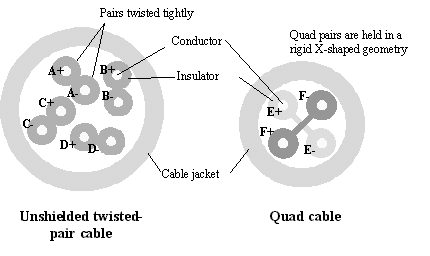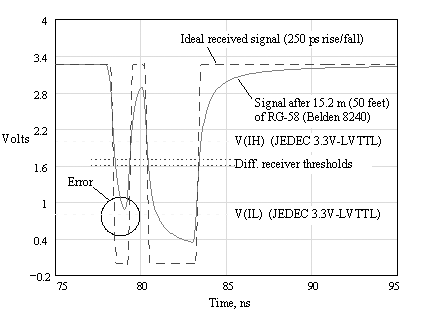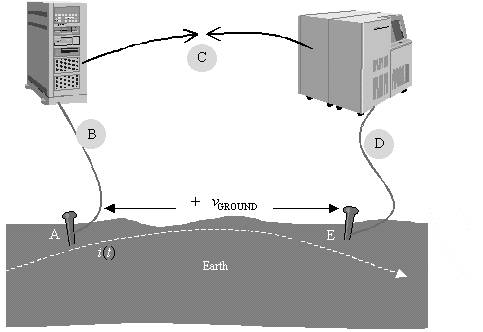Intercabinet Applications
The term used to describe the high-speed differential wiring often used between pieces of equipment is balanced cabling . This term has been adopted by the ISO building-wiring standards committee to describe any cable that provides one or more pairs of wire, each pair having a defined differential-mode impedance and each pair having a defined immunity to crosstalk from the other pairs within the same jacket.
There are two basic construction techniques used to produce balanced cabling: the twisted pair and the quad configuration (see Figure 6.30). Both arrangements hold the wires of each pair in a fixed arrangement with a uniform cross section. This stabilizes the differential impedance of the cable. Both guarantee low crosstalk among the pairs.
Figure 6.30. Construction of balanced cables.

The twisted-pair cable guarantees low crosstalk by virtue of having a different rate of twist on all the pairs within the same jacket. The different rates of twisting are an essential part of the crosstalk cancellation process. This happens because of the way transmission-line coupling works between two adjacent differential pairs. The basic rule of thumb for pair-wise crosstalk is this: When you flip one pair, the crosstalk reverses polarity .
A corollary to the flipping rule is this: When you flip both pairs, the crosstalk retains the same polarity . That might happen often if the twist rates were the same on two adjacent pairs. Every time both pairs flipped over, the crosstalk would remain the same. The crosstalk therefore might never cancel. To avoid this effect, the pairs in a multi-pair twisted cable are usually twisted at different rates. This randomizes the relation of one pair vis- -vis its partner, nulling out the crosstalk.
On a well- constructed twisted-pair cable, one of the colored pairs will carry a noticeably tighter twist than the others. The crosstalk to and from this pair will be the best in the bunch, a nice property. Do not, however, be deluded into thinking that all cables will have the same hierarchy of twist performance. There are few, if any, standards concerning which of the pairs should carry the tightest twist. Manufacturers are free to change the twist pattern at will, including reassignment of the hierarchy of twist performance. The crosstalk standards for most cables specify only the worst-case crosstalk between any two pairs. They do not designate any particular pairs as having better performance than the others.
The quad cable guarantees low crosstalk by virtue of its unique geometrical alignment. Both capacitive and inductive coupling mechanisms between the pairs are cancelled by this construction technique. With regards to interpair crosstalk within the same jacket, quad cable, if carefully constructed, can exceed the performance of twisted-pair cabling. With regards to crosstalk with other objects and cables outside the jacket, quad cable performs less well than twisted-pair cable. Twisted-pair cable does a better job of canceling electromagnetic radiation from the cable and providing good common-mode rejection .
The following sections describe the main applications for balanced cabling between cabinets .
POINTS TO REMEMBER
- The twisted-pair cable guarantees low crosstalk by virtue of having a different rate of twist on all the pairs within the same jacket.
- Quad cable guarantees low crosstalk by virtue of its unique geometrical alignment.
6.12.1 Ribbon-Style Twisted-Pair Cables
Ribbon-style twisted-pair cables have the same twist pitch on all pairs and yet still deliver reasonable crosstalk performance. It seems counterintuitive that this would work, because when one pair twists (inverting its local field polarity) the adjacent pair twists as well (inverting its sensitivity). The crosstalk would seem to reinforce with the same polarity at every twist. How can it work?
This paradox is solved by looking closely at the exact variations in crosstalk as the wires turn about one another. Imagine an axis run horizontally through the centerline of both pairs. Now imagine you can continuously control the angle of rotation on each pair about their respective axes. Begin with a rotational phase of 0 ° (left view in Figure 6.31). The coupling for this configuration is dominated by the inside two wires, A “ to B+, and so has a negative polarity.
Figure 6.31. In a twisted ribbon cable the crosstalk coupling polarity reverses every 90 °.

At a rotational phase of 90 ° (right view in Figure 6.31), the coupling changes dramatically. In this case the A+ wire couples mostly to B+, and A “ to B “, yielding a coupling amplitude almost exactly the same as in the previous case, but with opposite (positive) polarity.
The coupling reverts to the original (negative) polarity at 180 ° and inverts back to positive once again at 270 °. As long as the rotational axes of each pair is held in a fixed position, the coupling averaged throughout the entire rotational cycle nulls to near zero. The wires of a twisted ribbon cable are varnished into place to ensure they maintain the correct geometry. Different arrangements of the starting phases and rotational directions are possible.
In a practical, multipair, jacketed cable it is not generally possible to hold all the wires in fixed positions . The wires in the 90 ° case are likely to slump towards each other, upsetting the cancellation. To circumvent this difficulty the manufacturers of multi-pair twisted cables resort to the ruse of varying the twist rate on each pair.
POINT TO REMEMBER
- Ribbon cables can use the same twist pitch on every pair because the wires are held in a rigid geometry.
6.12.2 Immunity to Large Ground Shifts
Differential signaling with unshielded twisted-pair cables does not require a direct ground connection between the two ends of the link. As long as the potential difference between the transmitter and receiver remains within the common-mode input range of the receiver, the system will function. In most cases, the existing green-wire ground connection implemented on most computer equipment keeps the product chassis at either ends of the link within an acceptable voltage range (see box). No additional grounding needs be added to the system.
High-frequency single-ended signaling, on the other hand, does require a direct ground connection between the two ends of the link. Because this ground connection carries high-frequency returning signal currents, it must follow closely along with the signal wires in a low-inductance, controlled-impedance structure. The green-wire ground is woefully inadequate for this purpose. If single-ended signaling is to be used between cabinets, additional grounding means (such as a coaxial cable shield) must be implemented.
These additional grounding means may violate one of the most sacred AC power safety principles:
Never introduce a metallic connection between any two frames powered by different AC power sources .
As explained in the box "Earth Potential," violation of this rule may draw significant currents through the green-wire connection. This is a problem because it upsets the sensitive green-wire current detectors built into the main electrical panel of most modern buildings . These detectors look for early warning signs of electrical malfunction. For example, a partial short between any hot wire and a product chassis will transmit green-wire currents back to the electrical panel where they may be detected . The circuit that detects these currents is called a ground-fault interrupter, or GFI , circuit breaker. When the detected current exceeds a critical threshold, power may be removed from that section of the building. Messing with the green wire is serious stuff. Don't do it.
If you must electrically connect the metallic frames of two systems, make sure that both systems are served by a green-wire ground connected to the same Earth potential. There are multiple ways to do this. For systems located within the same rack-mounted chassis, just screw all the frames to the same rack. For boxes located in the same room, but not in the same rack, provide a way to plug the AC power cord of one system into a convenience outlet on the other system. This arrangement daisy chains the green-wire connections, so you know they are all at the same potential. If daisy chaining is not possible, try to plug all the systems into the same outlet or power strip. For boxes located within different rooms, use differential signaling, fiber, or RF connections that don't require a metallic connection between frames.
POINTS TO REMEMBER
- Never introduce a metallic connection between any two frames powered by different AC power sources.
- If you must electrically connect two boxes, make sure that both boxes are served by green-wire grounds connected to the same Earth potential.
- Differential signaling with unshielded cables does not require a direct ground connection between the two ends of the link.
6.12.3 Rejection of External Radio-Frequency Interference (RFI)
External RF fields impinging on a twisted-pair cable tend to affect both wires equally. Any interference mostly appears as a common-mode signal on the cable, which is cancelled at the receiver. I say mostly because, as usual, a number of things can go wrong. As good as twisted-pair cables are for rejecting RF interference, here's what happens in the real world:
- Part of the RF field energy is absorbed by the cable. This has to do with the efficiency of the complete cable structure as an electrical antenna, a subject outside the bounds of this book. For more information about antenna efficiency as it relates to RFI problems, see the excellent text by Clayton Paul [57] .
- The RF field energy absorbed is converted to a common-mode current. This happens according to the relation
 , where P is the power received and Z COMMON is the common-mode impedance of the cable, with respect to true Earth ground, including its common-mode terminations.
, where P is the power received and Z COMMON is the common-mode impedance of the cable, with respect to true Earth ground, including its common-mode terminations. - If the common mode of propagation is unterminated at both ends of the cable (as it would be using ordinary transformer-coupling at both ends), a significant resonance may occur that amplifies the received common-mode current.
- Some fraction of the common-mode current flowing in the cable is converted to a differential-mode current. This conversion may take place due to a natural imbalance in the construction of the cable itself, an imbalance in the connectors, or an imbalance in the transmitter or receiver circuitry .
- The receiver interprets the differential-mode current as a true differential signal.
POINTS TO REMEMBER
To get the best RF-rejection performance from your cabling,
- Use a tightly twisted, well-balanced cable. Twisted cables work better than quad cables in this respect.
- Don't scrimp on connectors. Buy and use connectors designed to go with the cable.
- Use well-balanced circuitry for both transmitter and receiver.
6.12.4 Differential Receivers Have Superior Tolerance to Skin Effect and Other High-Frequency Losses
Let's say you need to communicate one digital signal from box A to box B located 15.2 m (50 feet) away. You choose a single-ended 3.3-V 50-ohm line driver, running on RG-58 coax at 1000 Mbaud (one nanosecond per bit), with a rise/fall time of 250 ps.
The response of this system is shown in Figure 6.33. The figure shows the actual eye pattern, as predicted by simulation, using solid lines. The ideal transmitted waveform, assuming no skin-effect distortion or attenuation, is depicted with a dashed line. The transmitted data pattern is ...1111010001111....
Figure 6.33. Fifty feet of Belden RG-58 distorts this 1-Gb/s signal.

The worst-case high and low receiver thresholds for single-ended 3.3-V JEDEC LVTTL logic are drawn in place at 2.0 and 0.8 volts respectively. Notice that the low-side threshold fails to catch the first negative-going excursion ” causing a bit error. Even when the LVTTL receiver does properly interpret the data, you can expect a fair amount of jitter in the received waveform.
Differential receivers are commonly specified with more accurate switching thresholds than ordinary single-ended logic. Had you selected a differential receiver and a differential cabling system, the effective receiver thresholds would have been more nearly centered in the middle of the data pattern.
For example, the chart shows the differential receiver thresholds for LVDS logic. These thresholds still properly discriminate the data even in the face of severe pulse distortion. In general, for the same amount of transmission-line distortion, a differential receiver generates less jitter than a single-ended receiver. This advantage follows from the generally better threshold tolerances available in differential receivers, not of the differential architecture itself.
In the example of Figure 6.33, you could improve the single-ended system performance by using a differential receiver with its negative input terminal tied to a stable and accurate source of 1.65 V. That simple change would create a single-ended receiver with much better control over the input threshold than indicated in the figure.
If the transmission cable is end- terminated , the end termination is best tied to some voltage halfway between V IH and V IL (or tied to a split terminator with a Thevenin equivalent voltage between V IH and V IL ). That way the DC attenuation of the cabling symmetrically affects both high and low logic levels, keeping the received signal centered.
POINT TO REMEMBER
- Differential receivers have more accurate switching thresholds than ordinary single-ended logic.
Fundamentals
- Impedance of Linear, Time-Invariant, Lumped-Element Circuits
- Power Ratios
- Rules of Scaling
- The Concept of Resonance
- Extra for Experts: Maximal Linear System Response to a Digital Input
Transmission Line Parameters
- Transmission Line Parameters
- Telegraphers Equations
- Derivation of Telegraphers Equations
- Ideal Transmission Line
- DC Resistance
- DC Conductance
- Skin Effect
- Skin-Effect Inductance
- Modeling Internal Impedance
- Concentric-Ring Skin-Effect Model
- Proximity Effect
- Surface Roughness
- Dielectric Effects
- Impedance in Series with the Return Path
- Slow-Wave Mode On-Chip
Performance Regions
- Performance Regions
- Signal Propagation Model
- Hierarchy of Regions
- Necessary Mathematics: Input Impedance and Transfer Function
- Lumped-Element Region
- RC Region
- LC Region (Constant-Loss Region)
- Skin-Effect Region
- Dielectric Loss Region
- Waveguide Dispersion Region
- Summary of Breakpoints Between Regions
- Equivalence Principle for Transmission Media
- Scaling Copper Transmission Media
- Scaling Multimode Fiber-Optic Cables
- Linear Equalization: Long Backplane Trace Example
- Adaptive Equalization: Accelerant Networks Transceiver
Frequency-Domain Modeling
- Frequency-Domain Modeling
- Going Nonlinear
- Approximations to the Fourier Transform
- Discrete Time Mapping
- Other Limitations of the FFT
- Normalizing the Output of an FFT Routine
- Useful Fourier Transform-Pairs
- Effect of Inadequate Sampling Rate
- Implementation of Frequency-Domain Simulation
- Embellishments
- Checking the Output of Your FFT Routine
Pcb (printed-circuit board) Traces
- Pcb (printed-circuit board) Traces
- Pcb Signal Propagation
- Limits to Attainable Distance
- Pcb Noise and Interference
- Pcb Connectors
- Modeling Vias
- The Future of On-Chip Interconnections
Differential Signaling
- Differential Signaling
- Single-Ended Circuits
- Two-Wire Circuits
- Differential Signaling
- Differential and Common-Mode Voltages and Currents
- Differential and Common-Mode Velocity
- Common-Mode Balance
- Common-Mode Range
- Differential to Common-Mode Conversion
- Differential Impedance
- Pcb Configurations
- Pcb Applications
- Intercabinet Applications
- LVDS Signaling
Generic Building-Cabling Standards
- Generic Building-Cabling Standards
- Generic Cabling Architecture
- SNR Budgeting
- Glossary of Cabling Terms
- Preferred Cable Combinations
- FAQ: Building-Cabling Practices
- Crossover Wiring
- Plenum-Rated Cables
- Laying Cables in an Uncooled Attic Space
- FAQ: Older Cable Types
100-Ohm Balanced Twisted-Pair Cabling
- 100-Ohm Balanced Twisted-Pair Cabling
- UTP Signal Propagation
- UTP Transmission Example: 10BASE-T
- UTP Noise and Interference
- UTP Connectors
- Issues with Screening
- Category-3 UTP at Elevated Temperature
150-Ohm STP-A Cabling
- 150-Ohm STP-A Cabling
- 150- W STP-A Signal Propagation
- 150- W STP-A Noise and Interference
- 150- W STP-A: Skew
- 150- W STP-A: Radiation and Safety
- 150- W STP-A: Comparison with UTP
- 150- W STP-A Connectors
Coaxial Cabling
- Coaxial Cabling
- Coaxial Signal Propagation
- Coaxial Cable Noise and Interference
- Coaxial Cable Connectors
Fiber-Optic Cabling
- Fiber-Optic Cabling
- Making Glass Fiber
- Finished Core Specifications
- Cabling the Fiber
- Wavelengths of Operation
- Multimode Glass Fiber-Optic Cabling
- Single-Mode Fiber-Optic Cabling
Clock Distribution
- Clock Distribution
- Extra Fries, Please
- Arithmetic of Clock Skew
- Clock Repeaters
- Stripline vs. Microstrip Delay
- Importance of Terminating Clock Lines
- Effect of Clock Receiver Thresholds
- Effect of Split Termination
- Intentional Delay Adjustments
- Driving Multiple Loads with Source Termination
- Daisy-Chain Clock Distribution
- The Jitters
- Power Supply Filtering for Clock Sources, Repeaters, and PLL Circuits
- Intentional Clock Modulation
- Reduced-Voltage Signaling
- Controlling Crosstalk on Clock Lines
- Reducing Emissions
Time-Domain Simulation Tools and Methods
- Ringing in a New Era
- Signal Integrity Simulation Process
- The Underlying Simulation Engine
- IBIS (I/O Buffer Information Specification)
- IBIS: History and Future Direction
- IBIS: Issues with Interpolation
- IBIS: Issues with SSO Noise
- Nature of EMC Work
- Power and Ground Resonance
Points to Remember
Appendix A. Building a Signal Integrity Department
Appendix B. Calculation of Loss Slope
Appendix C. Two-Port Analysis
- Appendix C. Two-Port Analysis
- Simple Cases Involving Transmission Lines
- Fully Configured Transmission Line
- Complicated Configurations
Appendix D. Accuracy of Pi Model
Appendix E. erf( )
Notes
EAN: N/A
Pages: 163
- Integration Strategies and Tactics for Information Technology Governance
- An Emerging Strategy for E-Business IT Governance
- Assessing Business-IT Alignment Maturity
- A View on Knowledge Management: Utilizing a Balanced Scorecard Methodology for Analyzing Knowledge Metrics
- Governance in IT Outsourcing Partnerships

